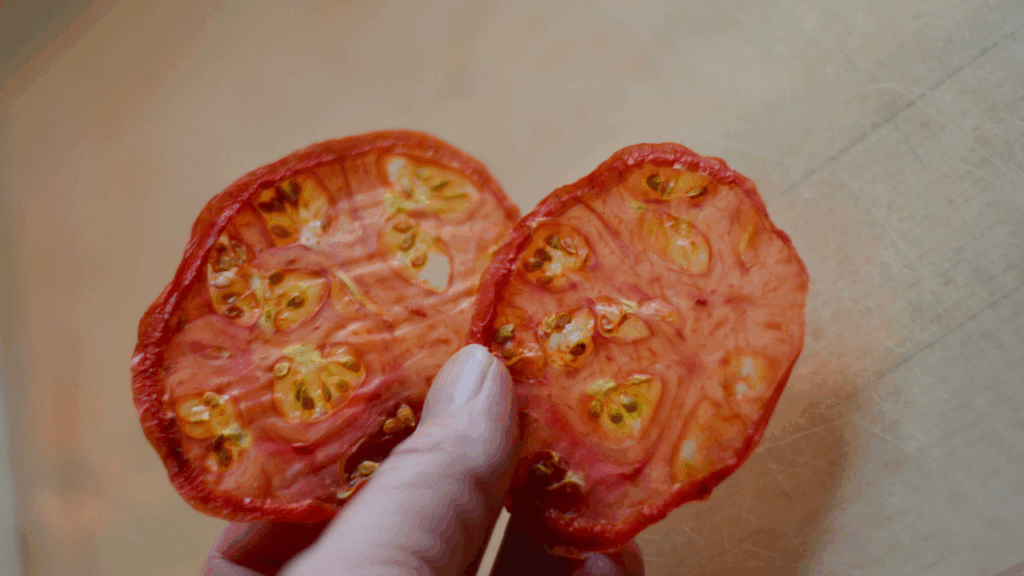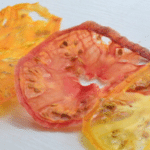Last Updated on November 29, 2025 by Michelle
Tomato powder has, quite literally, changed my life.
I used to be afraid to admit that I hate canning. But, there, I said it.
The funny thing? Once I admitted my adversion to canning, that lead me into learning about dehydrating tomatoes. And then I started making tomato powder. Game changer.
It used to be a far-fetched dream of mine to not buy pasta sauce at the store anymore. It’s now been a full-blown reality for years.
So join me on the dehydrating side–there’s a ton less dishes and sweaty days spent slaving over hot stoves.
Should I dehydrate or can my tomatoes?
I should clarify. If you, somehow, just LOVE canning and want to can your tomatoes, I’m not here to tell you to stop canning. Ahem. I’m just here to tell you that dehydrating is objectively better, ha.
Canning tomatoes vs. dehydrating:
Canning tomatoes can be more convenient depending on how you look at it. It is really nice to just pop open a jar of tomatoes or pasta sauce and have that be the extent of your work when you’re cooking. Just heat your sauce and go.
Sometimes canning is also preferred because you’re less limited in how much you can make at a time. Especially if you have more than one canner, you can whip up really large batches of tomatoes and/or sauce to can, whereas if you’re dehydrating you are limited in how much you can preserve in one batch, then you’ll have to wait until one batch is dry before starting the next.
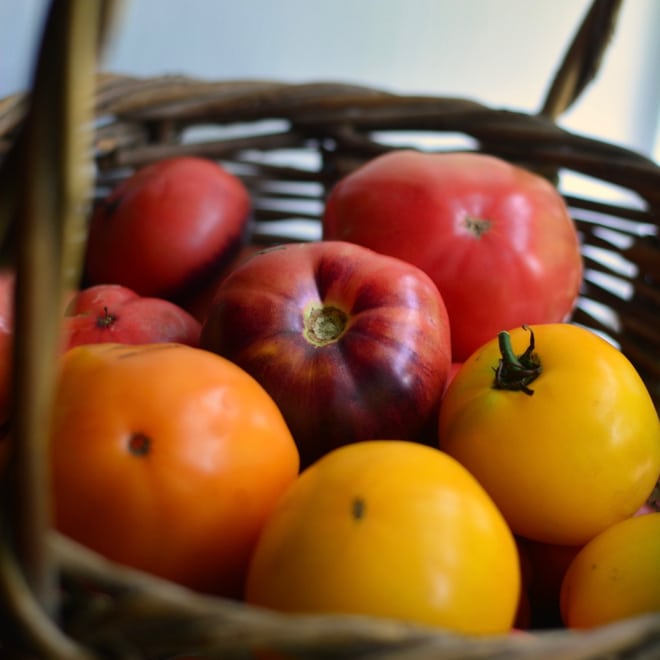
Dehydrating tomatoes vs. canning:
On the other hand, canning requires more preparation and equipment than dehydrating does. More than once I’ve gotten halfway through a canning project before realizing I didn’t have enough lids or ingredients to finish the batch. With dehydrating, you literally just need your dehydrator and you’re always good to go.
Dehydrating also allows you to work in batches, which can be a good thing. Last summer I got into a really soothing rhythm of starting a batch of tomatoes in the dehydrator before bed, checking them in the morning, and letting them run into the late morning until they were done. It’s refreshing to not have to cram all my preserving into a few huge, long, sweaty days.
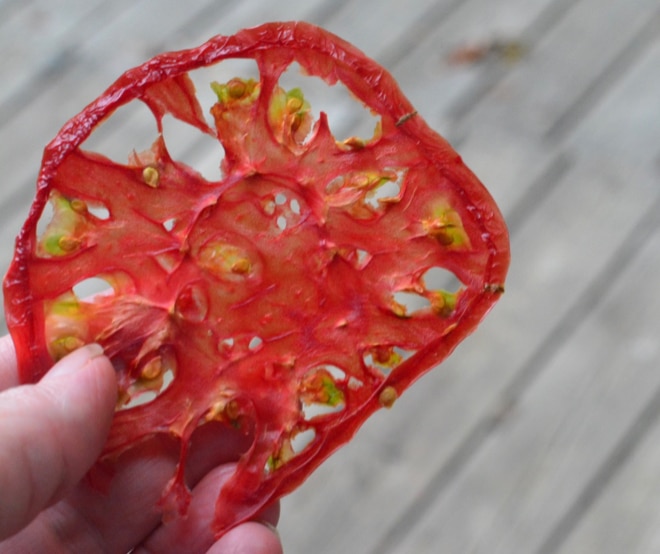
Why dehydrate tomatoes instead of canning?
There are tons of upsides to dehydrating tomatoes, making dehydrating preferable to canning:
- You avoid huge, messy, sweaty canning days laboring in a hot kitchen. To me, dehydrating is calmer than canning, requires a lot less focus and time, and is just more enjoyable in general.
- Dehydrated tomatoes take less space to store than canned ones do. I stored all my tomatoes for the entire year in TWO flats worth of jars. If I had canned all those tomatoes, it would probably have taken up an entire shelf (or more) in my root cellar. Instead, I dehydrated them and saved a ton of space.
- Tomatoes that are dehydrated preserve more nutrients than canned. All the processing, heating, and boiling involved in canning tomatoes leads to more nutrient loss. Dehydrating at low temperatures simply requires cutting whole tomatoes and removing their moisture in a dehydrator. In fact, according to this chart, canned foods can loose up to 80% of their nutrients, while dehydrated foods never loose more than 5%.
- Using dehydrated tomato slices and powders is just so convenient. I store a jar of tomato powder in my pantry at all times, and when I need some pasta sauce I simply mix the exact amount I need by mixing hot water into my tomato powder. So simple, so easy, and there’s less waste because I can make exactly how much sauce I need, versus having to open a whole jar.
- Dehydrating has a lower risk of spoilage (since the food has virtually no moisture in it), and is considered easier and safer than canning for beginners.
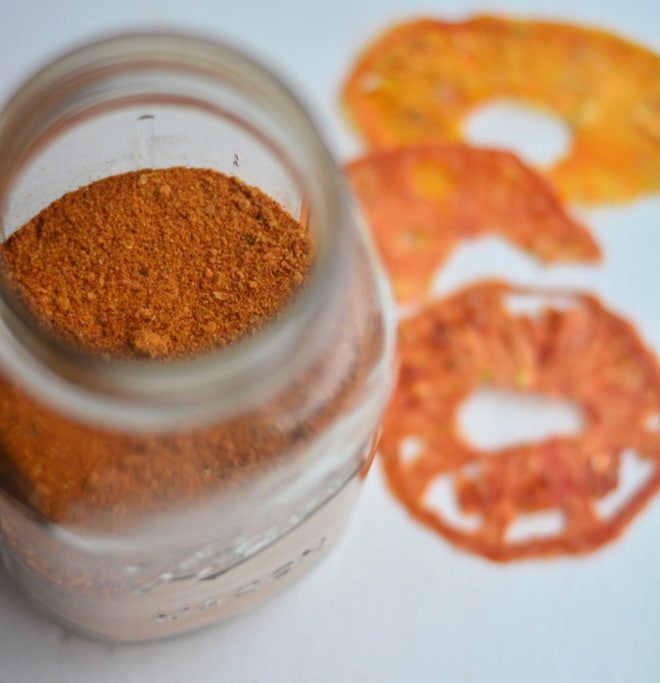
How to dehydrate tomatoes 101
There are several different ways to dehydrate tomatoes. My two favorites are to dehydrate tomato slices, and dehydrate tomato “leather” to turn into powder.
I love using the slices (rehydrated) on top of pizza, in soups/stews, and on top of salads. The tomato leather-turned-powder gets used as pasta sauce, tomato paste, and even tomato soup. It can get jazzed up or left plain, made as thick/thin as you need, and can even be used as a thickener for gravy.
To dehydrate tomato slices:
If you mind skins on your tomato slices, you’ll want to start by peeling your tomatoes. If not, just leave the skins on.
- Wash and ore your tomatoes, then set the aside. Make sure you don’t prep more than you can fit into your dehydrator in a load.
- Slice your tomatoes as thin as you can (to reduce drying time), but most importantly make sure your slices are as uniform as they can be.
- Place your slices either directly on your dehydrator trays, or onto silicone liners, depending on your machine. I find they dry faster directly on the trays, but they also stick more, which is why the liners are helpful. Make sure the slices are single layer and not overlapping.
- Dehydrate your tomato slices at 135 degrees for anywhere from 6-12 hours, depending on how thick/thin your slices are. Flipping your tomato slices halfway through will significantly reduces your drying time and help them dry more evenly.
- Check your tomatoes frequently to check for dryness. Fully dehydrated tomatoes should feel dry and leathery, slightly crispy. If they’re turning a dark color or overly crispy they might be overdone. If they’re soft or still feel moist at all, they’re not done yet.
- Make sure your tomatoes are completely cool before sealing in an airtight container. Any heat left in the tomatoes can lead to moisture building up, which can allow them to go bad.
- Condition your tomatoes for about a week by vigorously shaking them every day. I like to use a half gallon jar for this, filling it only 1/2-3/4 full to allow room for shaking. Conditioning is a really important step in the dehydrating process, so don’t skip this step. Almost 100% of the time when I hear of someone being discouraged with their dehydrated food, it’s because they didn’t condition it properly after dehydrating. See more about conditioning below.
- Store your dehydrated tomato slices in an airtight container indefinitely. Especially if you’re planning on storing them super long-term, check them every so often to make sure there’s no signs of moisture or mildew.
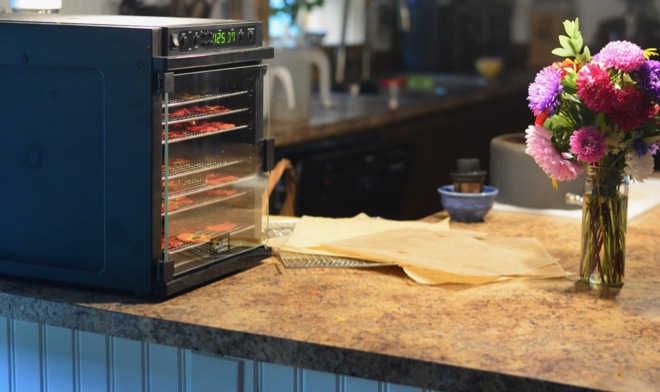
To dehydrate tomato leather/powder:
Dehydrated tomato slices are great, but my absolute favorite (and easiest) way to dehydrate tomatoes is to turn them into a tomato leather, then blend that leather into a powder. It completely eliminates the slicing step! The only caveat to this method is that you do need to have some form of liners for your dehydrator, or else the tomato puree will just run right through your trays. You can try using parchment paper instead of “real” liners, but it sometimes rips/leaks.
- Dump all your washed and cored tomatoes into a blender. (Don’t tell the experts, but I will even leave my cores in…)
- Blend those into a liquid-y tomato smoothie (my daughter has been known to call it “vomit” because it… well… does have a resemblance, even more so depending on what kinds/colors of tomatoes you’re using… I grow a lot of yellow and orange tomato varieties).
- Carefully pour your tomato puree onto your lined dehydrator trays and spread it out with a spatula. DON’T pour more puree than will fit on your trays. You’ll want to leave about 1/2-1 inch of space around the edges of your trays to allow it to spread and settle a bit without leaking off the trays.
- Dehydrate at 135 degrees for 8-12 hours. You’ll know they’re done when the tomato “leather” breaks into pieces when you try to break it in half, rather than bending.
- Once your tomato leather is all dry, stuff the cooled leather into a DRY blender (again) to blend it into a powder.
- Condition your tomato powder in the oven. Don’t skip this step or you’ll have a tomato brick in a few months. Preheat your oven to 150 degrees and TURN IT OFF. Place your powder on parchment paper, on a cookie tray, and place the tray in the turned off oven for ½ an
hour.
-
Store your tomato powder in airtight jars or containers until you want to use it. If you want my exact recipe for turning your (plain) tomato powder into ready-to-use pasta sauce powder (just add water!), see this recipe.
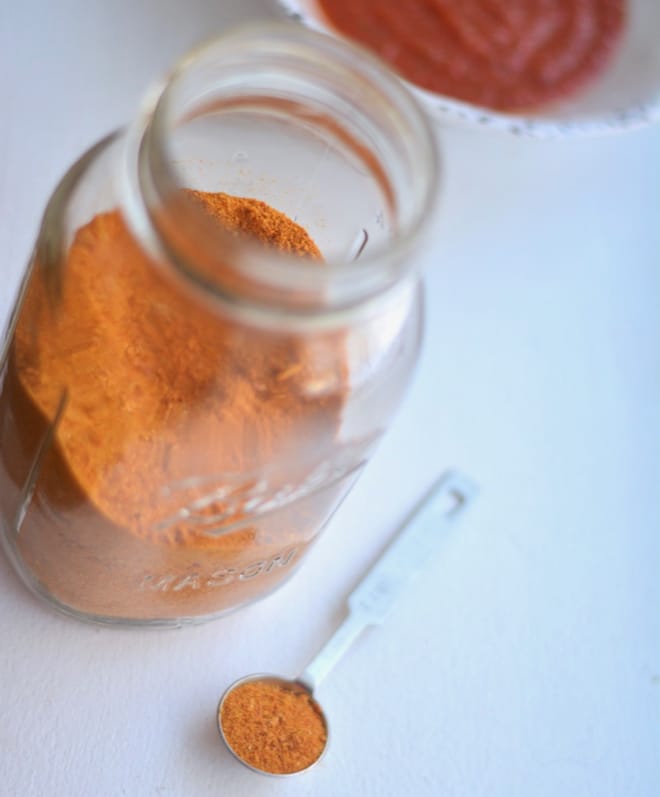
Why condition dehydrated tomatoes?
Conditioning dehydrated food is a super important step of the process. 9 times out of 10 when I get a message about someone being discouraged dehydrating, it’s because they were never told to condition their food.
Conditioning is essentially just shaking your dehydrated food at least once a day for about a week. After that week, your food should be good to go.
Shaking your dehydrated tomatoes allows you to check them for any moisture and quickly see and remove any parts that aren’t 100% dry. It also helps prevent your tomato slices from sticking together, preventing you from having one large, sticky ball of sorta-dehydrated tomatoes. If, during the conditioning process, you do find some sticky, not fully-dry tomato slices, just stick those ones back into your dehydrator until they’re fully dry.
Conditioning tomato powder makes sure than any heat/moisture caused from re-blending the tomato leather into powder is removed. And it keeps you from having any large clumps in your powder.
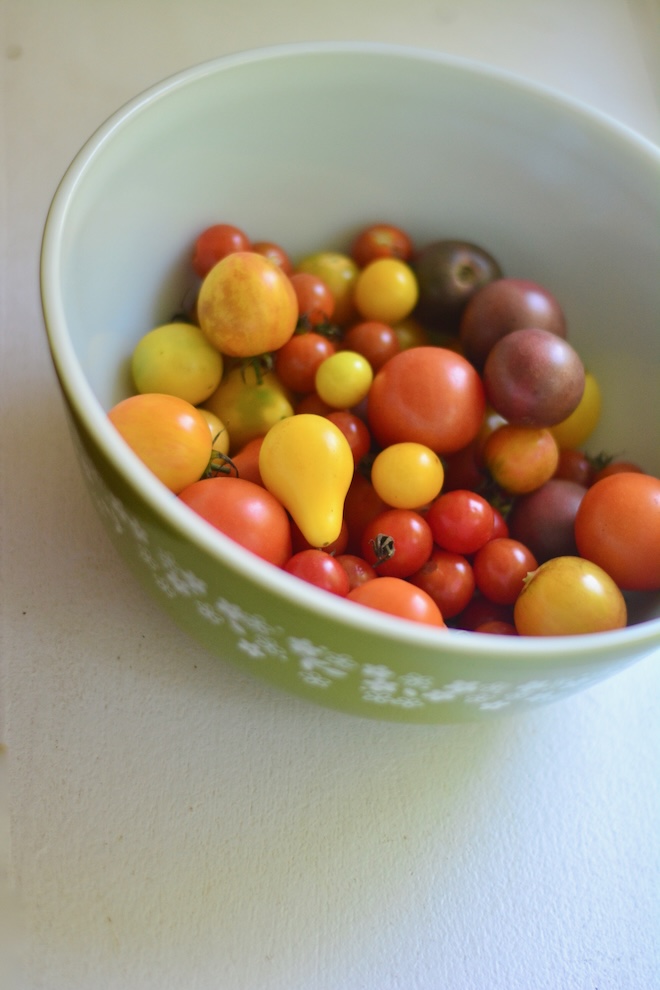
What types of tomatoes are best for dehydrating?
For a full list (with more details) of my favorite tomatoes for dehydrating, see this list.
While literally any tomatoes can be dehydrated very easily, these are some of my favorites. If they made this list, it’s because they’re easy to slice, not too watery so they take forever to dehydrate, and taste good re-hydrated. This is by no means an exhaustive list (obviously), but just the varieties I’ve grown that I’ve found be be extra good for dehydrating.
If you’re making tomato leather/powder, the variety doesn’t matter much. This list (in descending order, with my favorite first) is more for dehydrating slices than leather. I even throw any extra cherry tomatoes I have lying around into the mix when I’m making tomato leather.
- Golden Queen
- Blue Beauty
- German Pink
- Black Cherry tomatoes (sliced)
- Hillbilly
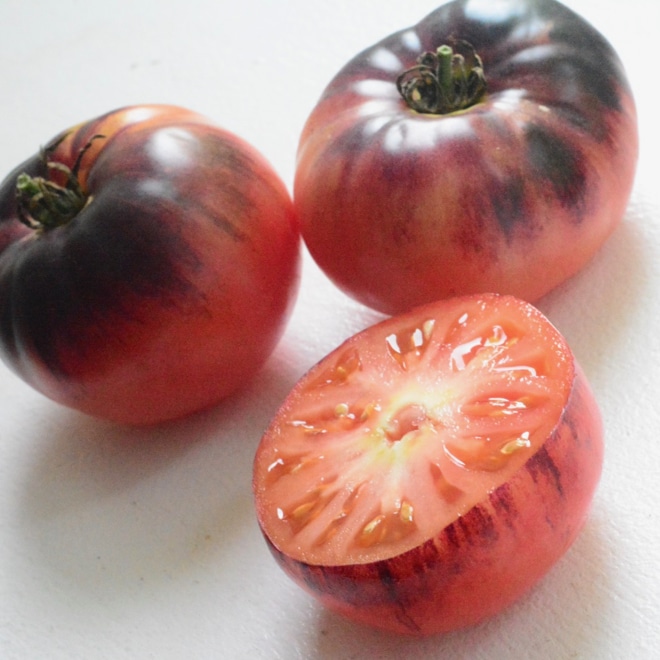
How to use dehydrated tomatoes
I’ve gotten so used to using dehydrated tomatoes and tomato powder that I forget it isn’t normal for everyone. There are a million ways to use dehydrated tomatoes, and I’ll share a few of my favorites, but the list is really endless.
- Use dehydrated tomato powder as a natural thickener in gravy, soups, stews. It’s better for you than cornstarch, and works like magic.
- Re-hydrate tomato slices to use as a pizza topping, or on salads or sandwiches.
- Enjoy dehydrated tomatoes as they are for a snack. You’ve heard of snacking on dehydrated fruits, why not tomatoes?
- Make pasta sauce with dehydrated tomatoes/powder. This is my #1 favorite way to use dehydrated tomatoes, since we LOVE a good red sauce–spaghetti, lasagna, with meatballs, you name it. Find my full recipe for pasta sauce made with dehydrated tomato powder here.
- Add dehydrated tomatoes to soups, stews, crockpot meals, and literally anything calling for diced or canned tomatoes. Just re-hydrate your tomato slices, chop them up if needed, and you’re golden.
- Sprinkle tomato powder on eggs or popcorn for pizza goldfish vibes.
- Add dehydrated tomato pieces straight into bread dough for sundried tomato flavor.
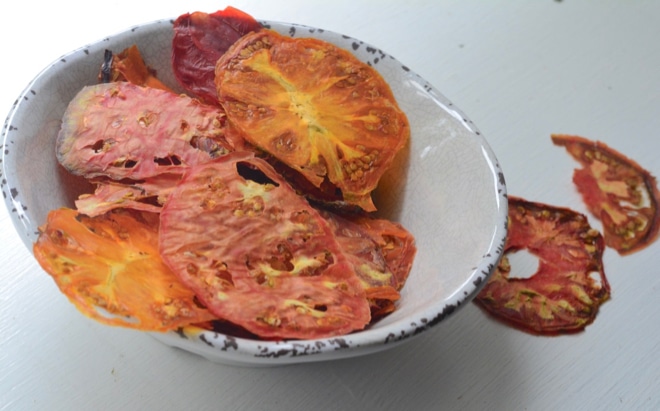
Dehydrating tomatoes
Equipment
- dehydrator
- Blender (if making leather/powder)
Materials
- Ripe, garden-fresh tomatoes
Instructions
For making dehydrated tomato slices:
- Wash and ore your tomatoes, then set the aside. Make sure you don't prep more than you can fit into your dehydrator in a load.
- Slice your tomatoes as thin as you can (to reduce drying time), but most importantly make sure your slices are as uniform as they can be.
- Place your slices either directly on your dehydrator trays, or onto silicone liners, depending on your machine. I find they dry faster directly on the trays, but they also stick more, which is why the liners are helpful. Make sure the slices are single layer and not overlapping.
- Dehydrate your tomato slices at 135 degrees for anywhere from 6-12 hours, depending on how thick/thin your slices are. Flipping your tomato slices halfway through will significantly reduces your drying time and help them dry more evenly.
- Check your tomatoes frequently to check for dryness. Fully dehydrated tomatoes should feel dry and leathery, slightly crispy. If they're turning a dark color or overly crispy they might be overdone. If they're soft or still feel moist at all, they're not done yet.
- Make sure your tomatoes are completely cool before sealing in an airtight container. Any heat left in the tomatoes can lead to moisture building up, which can allow them to go bad.
- Condition your tomatoes for about a week by vigorously shaking them every day. I like to use a half gallon jar for this, filling it only 1/2-3/4 full to allow room for shaking. Conditioning is a really important step in the dehydrating process, so don't skip this step. Almost 100% of the time when I hear of someone being discouraged with their dehydrated food, it's because they didn't condition it properly after dehydrating. See more about conditioning below.
- Store your dehydrated tomato slices in an airtight container indefinitely. Especially if you're planning on storing them super long-term, check them every so often to make sure there's no signs of moisture or mildew.
For making dehydrated tomato leather/powder:
- Dump all your washed and cored tomatoes into a blender. (Don't tell the experts, but I will even leave my cores in...)
- Blend those into a liquid-y tomato smoothie (my daughter has been known to call it "vomit" because it... well... does have a resemblance, even more so depending on what kinds/colors of tomatoes you're using... I grow a lot of yellow and orange tomato varieties).
- Carefully pour your tomato puree onto your lined dehydrator trays and spread it out with a spatula. DON'T pour more puree than will fit on your trays. You'll want to leave about 1/2-1 inch of space around the edges of your trays to allow it to spread and settle a bit without leaking off the trays.
- Dehydrate at 135 degrees for 8-12 hours. You'll know they're done when the tomato "leather" breaks into pieces when you try to break it in half, rather than bending.
- Once your tomato leather is all dry, stuff the cooled leather into a DRY blender (again) to blend it into a powder.
- Condition your tomato powder in the oven. Don't skip this step or you'll have a tomato brick in a few months. Preheat your oven to 150 degrees and TURN IT OFF. Place your powder on parchment paper, on a cookie tray, and place the tray in the turned off oven for ½ an hour.
- Store your tomato powder in airtight jars or containers until you want to use it. If you want my exact recipe for turning your (plain) tomato powder into ready-to-use pasta sauce powder (just add water!), see this recipe.

